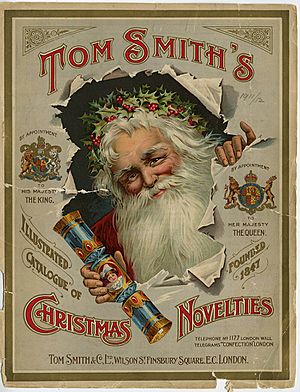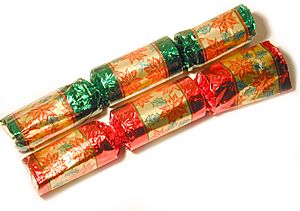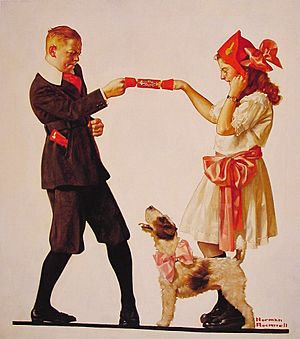Christmas cracker facts for kids
Christmas crackers are fun decorations for your Christmas table. When you pull them open, they make a snappy sound! Inside, you'll often find a small gift, a paper hat, and a joke. They are a big part of Christmas celebrations in the United Kingdom, Ireland, and other Commonwealth countries. These include places like Australia, Canada, New Zealand, and South Africa.
A cracker is made from a cardboard tube wrapped in colorful paper. It looks a bit like a giant candy wrapper. Two people pull the cracker apart, each holding one end. This makes it split unevenly. One person ends up with the middle part and the prize. The split makes a small bang or snap. This sound comes from a special strip inside that reacts to friction.
Contents
What's Inside a Christmas Cracker?
Crackers are usually pulled during Christmas dinner or at Christmas parties. When you pull a cracker, the person who gets the bigger end often gets to keep the surprises inside. Sometimes, everyone just keeps what's in their own cracker.
Christmas crackers traditionally hold a few fun things:
- A colorful crown-shaped hat made of tissue paper.
- A small toy, a plastic model, or a little trinket.
- A small strip of paper with a motto, a joke, a riddle, or a fun fact.
The paper hats look like crowns. People usually wear them while eating Christmas dinner. Wearing festive hats might come from ancient Roman times. During their Saturnalia celebrations, people also wore decorative headgear.
Christmas crackers are also linked to parties in Sweden. These are called Knut's parties and happen at the end of the Christmas season.
Who Invented Christmas Crackers?
The idea of pulling "crackers" has been around since 1847.
Tom Smith's Sweet Idea

A man named Tom Smith (1823–1869) from London is said to have invented Christmas crackers in 1847. He first made special bon-bon sweets. He sold these sweets wrapped in twisted paper. This was the start of the sweet wrapper we know today.
When sales of his bon-bons slowed down, Smith thought of new ways to make them popular. First, he put love messages inside the sweet wrappers. This was similar to what fortune cookies do.
The "Crackle" Sound
Smith got the idea for the "crackle" sound from a fire. He heard a log crackle loudly when he put it on the fire. This inspired him to add a similar sound to his sweets. To fit the snapping part, he had to make the paper wrapper bigger. Eventually, the sweet itself was removed. Instead, he put in a small trinket, like fans or jewelry.
The new product was first called the Cosaque. This is French for Cossack. But the sound it made led to the name "cracker." Soon, other companies started making their own crackers.
Walter Smith's Innovations
Tom Smith's son, Walter Smith, added more things to the crackers. He put in the gifts, paper hats, and different designs. This helped his family's crackers stand out from others.
Tom Smith & Company later joined with Caley Crackers in 1953. There is a special water fountain in Finsbury Square, London, that remembers Tom Smith and his family.
Crackers in Art and Records
Artistic Crackers
A Christmas cracker is the main subject of a painting called The Party Favor. This oil painting was made by the American artist Norman Rockwell. It appeared on the cover of The Saturday Evening Post magazine in 1919.
World Records with Crackers
The longest chain of people pulling Christmas crackers happened in London. It involved 1081 people. This record was set by The Harrodian School on December 10, 2015.
On August 17, 2020, during a TV show, British comedian Alan Davies set a Guinness World Record. He pulled the most crackers by one person in 30 seconds. He managed to pull 35 crackers successfully. This record was later broken by Joel Corry, who pulled 41 crackers in 2021.
Travel Rules for Crackers
If you are flying to or within the United States, you cannot bring Christmas crackers. They are not allowed in carry-on bags or checked luggage. In the United Kingdom, the rules can be different depending on the airline and airport.



